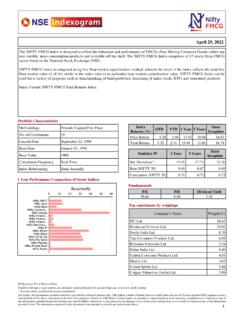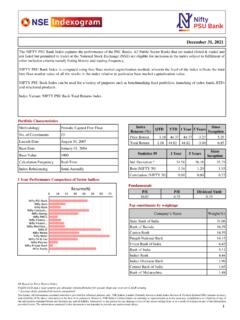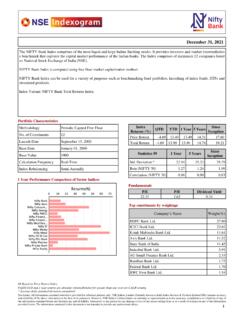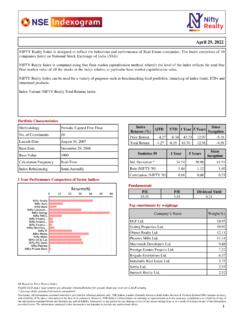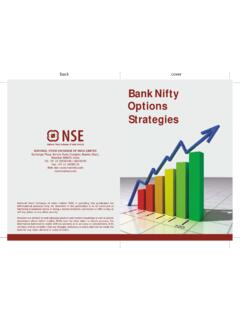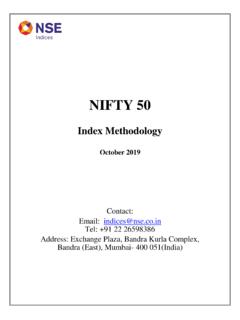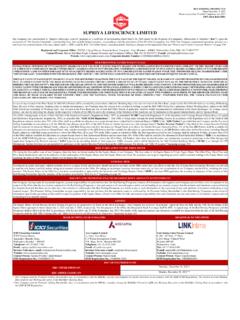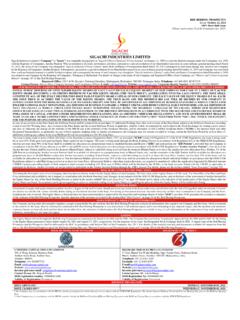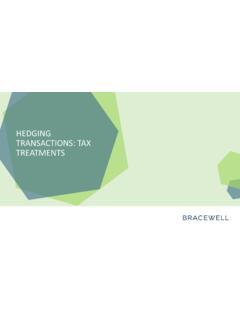Transcription of Copyright © 2009 by National Stock Exchange of India Ltd ...
1 Copyright 2009 by National Stock Exchange of India Ltd. (NSE) Exchange Plaza, Bandra Kurla Complex, Bandra (East), Mumbai 400 051 India All content included in this book, such as text, graphics, logos, images, data compilation etc. are the property of NSE. This book or any part thereof should not be copied, reproduced, duplicated, sold, resold or exploited for any commercial purposes. Furthermore, the book in its entirety or any part cannot be stored in a retrieval system or transmitted in any form or by any means, electronic, mechanical, photocopying, recording or otherwise. Preface The National Stock Exchange of India Ltd. (NSE), set up in the year 1993, is today the largest Stock Exchange in India and a preferred Exchange for trading in equity, debt and derivatives instruments by investors. NSE has set up a sophisticated electronic trading, clearing and settlement platform and its infrastructure serves as a role model for the securities industry.
2 The standards set by NSE in terms of market practices; products and technology have become industry benchmarks and are being replicated by many other market participants. NSE has four broad segments Wholesale Debt Market Segment (commenced in June 1994), Capital Market Segment (commenced in November 1994) Futures and Options Segment (commenced June 2000) and the Currency Derivatives segment (commenced in August 2008). Various products which are traded on the NSE include, equity shares, bonds, debentures, warrants, Exchange traded funds, mutual funds, government securities, futures and options on indices & single stocks and currency futures. Today NSE s share to the total equity market turnover in India averages around 72% whereas in the futures and options market this share is around 99%.
3 At NSE, it has always been our endeavour to continuously upgrade the skills and proficiency of the Indian investor. Exchange -traded options form an important class of derivatives which have standardized contract features and trade on public exchanges, facilitating trading among investors. They provide settlement guarantee by the Clearing Corporation thereby reducing counterparty risk. Options can be used for hedging , taking a view on the future direction of the market or for arbitrage. Options are also helpful for implementing various trading strategies such as straddle, strangle, butterfly, collar etc. which can help in generating income for investors under various market conditions. This module is being introduced to explain some of the important and basic Options strategies. The module which would be of interest to traders, investors, students and anyone interested in the options markets.
4 However, it is advisable to have a good knowledge about the basics of Options or clear the NCFM Derivatives Markets (Dealers) Module before taking up this module. To get a better clarity on the strategies, it is important to read the examples and the pay-off schedules. The pay-off schedules can be worked out using a simple excel spreadsheet for better understanding. We hope readers find this module a valuable addition which aids in understanding various Options Trading Strategies. 2 1. INTRODUCTION TO OPTION OPTIONS Payoff profile of buyer of asset: Long Payoff profile for seller of asset: Short Payoff profile for buyer of call options: Long Payoff profile for writer (seller) of call options: Short Payoff profile for buyer of put options: Long Payoff profile for writer (seller) of put options: Short STRATEGY 1 : LONG STRATEGY 2 : SHORT STRATEGY 3 : SYNTHETIC LONG STRATEGY 4 : LONG STRATEGY 5 : SHORT STRATEGY 6 : COVERED STRATEGY 7 : LONG STRATEGY 8 : PROTECTIVE STRATEGY 9 : COVERED STRATEGY 10 : LONG STRATEGY 11 : SHORT STRATEGY 12 : LONG STRATEGY 13.
5 SHORT STRATEGY 14. STRATEGY 15. BULL CALL SPREAD STRATEGY 16. BULL PUT SPREAD STRATEGY 17 : BEAR CALL SPREAD STRATEGY 18 : BEAR PUT SPREAD STRATEGY 19: LONG CALL STRATEGY 20 : SHORT CALL STRATEGY 21: LONG CALL STRATEGY 22 : SHORT CALL 3 OPTIONS 1. INTRODUCTION TO OPTIONS An option is a contract written by a seller that conveys to the buyer the right but not the obligation to buy (in the case of a call option) or to sell (in the case of a put option) a particular asset, at a particular price (Strike price / Exercise price) in future. In return for granting the option, the seller collects a payment (the premium) from the buyer. Exchange -traded options form an important class of options which have standardized contract features and trade on public exchanges, facilitating trading among large number of investors. They provide settlement guarantee by the Clearing Corporation thereby reducing counterparty risk.
6 Options can be used for hedging , taking a view on the future direction of the market, for arbitrage or for implementing strategies which can help in generating income for investors under various market conditions. OPTION TERMINOLOGY Index options: These options have the index as the underlying. In India , they have a European style settlement. Eg. Nifty options, Mini Nifty options etc. Stock options: Stock options are options on individual stocks. A Stock option contract gives the holder the right to buy or sell the underlying shares at the specified price. They have an American style settlement. Buyer of an option: The buyer of an option is the one who by paying the option premium buys the right but not the obligation to exercise his option on the seller/writer. Writer / seller of an option: The writer / seller of a call/put option is the one who receives the option premium and is thereby obliged to sell/buy the asset if the buyer exercises on him.
7 Call option: A call option gives the holder the right but not the obligation to buy an asset by a certain date for a certain price. Put option: A put option gives the holder the right but not the obligation to sell an asset by a certain date for a certain price. Option price/premium: Option price is the price which the option buyer pays to the option seller. It is also referred to as the option premium. Expiration date: The date specified in the options contract is known as the expiration date, the exercise date, the strike date or the maturity. Strike price: The price specified in the options contract is known as the strike price or the exercise price. American options: American options are options that can be exercised at any time upto the expiration date. European options: European options are options that can be exercised only on the expiration date itself.
8 4 In-the-money option: An in-the-money (ITM) option is an option that would lead to a positive cashflow to the holder if it were exercised immediately. A call option on the index is said to be in-the-money when the current index stands at a level higher than the strike price ( spot price > strike price). If the index is much higher than the strike price, the call is said to be deep ITM. In the case of a put, the put is ITM if the index is below the strike price. At-the-money option: An at-the-money (ATM) option is an option that would lead to zero cashflow if it were exercised immediately. An option on the index is at-the-money when the current index equals the strike price ( spot price = strike price). Out-of-the-money option: An out-of-the-money (OTM) option is an option that would lead to a negative cashflow if it were exercised immediately.
9 A call option on the index is out-of-the-money when the current index stands at a level which is less than the strike price ( spot price < strike price). If the index is much lower than the strike price, the call is said to be deep OTM. In the case of a put, the put is OTM if the index is above the strike price. Intrinsic value of an option: The option premium can be broken down into two components - intrinsic value and time value. The intrinsic value of a call is the amount the option is ITM, if it is ITM. If the call is OTM, its intrinsic value is zero. Putting it another way, the intrinsic value of a call is Max[0, (St K)] which means the intrinsic value of a call is the greater of 0 or (St K). Similarly, the intrinsic value of a put is Max[0, K St], the greater of 0 or (K St). K is the strike price and St is the spot price.
10 Time value of an option: The time value of an option is the difference between its premium and its intrinsic value. Both calls and puts have time value. An option that is OTM or ATM has only time value. Usually, the maximum time value exists when the option is ATM. The longer the time to expiration, the greater is an option's time value, all else equal. At expiration, an option should have no time value. OPTIONS PAYOFFS The optionality characteristic of options results in a non-linear payoff for options. In simple words, it means that the losses for the buyer of an option are limited, however the profits are potentially unlimited. For a writer (seller), the payoff is exactly the opposite. His profits are limited to the option premium, however his losses are potentially unlimited. These non-linear payoffs are fascinating as they lend themselves to be used to generate various payoffs by using combinations of options and the underlying.
